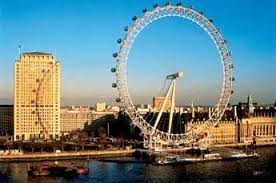The man in charge of London's Millennium Wheel tells Douglas Friedli about the ambitious scheme
07.11.2016
It will be the biggest wheel in the world - 135m high, weighing more than 1,500 tonnes and rotating at two revolutions an hour - if everything goes to plan.
It will be the biggest wheel in the world - 135m high, weighing more than 1,500 tonnes and rotating at two revolutions an hour - if everything goes to plan.

But some time in the next 10 days or so, in a dramatic and delicate operation, the wheel and its supporting pylon will be lifted upright.
The London Eye Company will not say exactly when this will happen, partly because the wind is a factor, but also because it wants to avoid attracting large crowds of spectators to a potentially dangerous site.
There is also the risk of embarrassment if the operation does not run smoothly. Caught squarely in the public gaze if that happens will be John Roberts, director of Allott & Lomax, engineer to the contract. His firm is overseeing the project, with its seven or eight separate supply contracts.
But Roberts says the prospect of raising the huge structure into place in such a prominent location is by no means his main worry. `The real headache, or rather the biggest challenge, is the fact that we are working with so many different countries, so many different designers, and then having to bring it all together,' he says.
However, he has no doubts about the quality of the individual parts. `It's something everyone has been very keen to be involved in, which means the quality of the work is incomparable.'
At the wheel's heart is a drive system made in Germany by Mannesman consisting of six hydraulic pumps - two 75kW main pumps and four 30kW auxiliary pumps. The pumps drive small wheels that turn against the rim of the big wheel. Because there is little friction in the structure, the engine does not need much power. When fully laden it should be perfectly balanced and very easy to move. Greater power will be needed when there are strong winds or when loading in the morning or emptying at night.
The wheel can take 800 passengers, but having 400 crowded on one side would make the structure harder to move. Roberts says there will be procedures to balance loads, such as loading every second capsule, and an operating limit during strong winds.
Given the size of the structure, the weather played a big part in the design of the wheel, by architects Mark Barfield and Julia Marks and design-and-build contractor Hollandia. It had to be strong enough to withstand gales, but too much substance would create wind resistance, hence the lightweight appearance.
Keeping the wheel turning will be two 2.6m high German-built FAG bearings, each with a nominal load capacity of around 1,000 tonnes. They are expected to be the largest working bearings in the UK, but they did not present much of a problem. `It would be exaggerating to call them off-the-shelf,' says Roberts, `but they are standard bearings. They are among the few pre-designed standard items on the project.'
The big problem, he adds, is the pylon that carries the wheel. `It is cantilevered out over the river, so it is technically one of the most complicated parts of the whole thing.'
It was fabricated by Hollandia in Rotterdam from castings made by Skoda in the Czech Republic. Skoda is now separate from the Volkswagen-owned car maker of the same name, as Roberts is at pains to point out: `In spite of people raising their eyebrows, Skoda is a very high-quality producer of cast steel.'
Roberts' main qualification for the wheel job was his work on theme park rides. His company's clients have included the UK's big two - Blackpool Pleasure Beach and Alton Towers. The company designed the Pepsi Max Big One, the UK's largest roller coaster. Roberts gets a thrill out of the Big One, and also enjoys the older rides such as Blackpool's Grand National.
The London Eye might not get the blood racing in quite the same way as a full-on roller coaster ride, but Roberts believes it will attract the public - even at a cost of £8 a ride. `The wheel is a different sort of thing. It will be the fourth tallest structure in London, with a 26-mile viewing radius and a fantastic bird's-eye view of central London which you probably can't get any other way.'
But the view may not last forever. Planning permission lasts for five years, when the city's authorities will decide the wheel's future. It could become as permanent as Vienna's 103-year-old, 63m-high Prater Wheel, immortalised in The Third Man, or disappear like a travelling fair.
Either way, it will make a dramatic impact on London's skyline for the start of the next millennium.
Link...













































